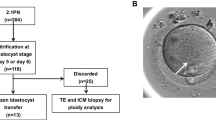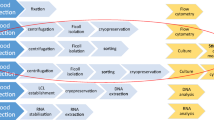Abstract
Purpose
The purpose of this study is to assess outcomes after magnetic-activated cell sorting (MACS) technology on obstetric and perinatal outcomes compared with those achieved after swim up from randomized controlled trial.
Methods
This is a two-arm, unicentric, prospective, randomized, and triple-blinded trial and has a total of 237 infertile couples, between October 2010 and January 2013. A total of 65 and 66 newborns from MACS and control group, respectively, were described.
Results
MACS had no clinically relevant adverse effects on obstetric and perinatal outcomes. No differences were found for obstetric problems including premature rupture of membranes 6.1% (CI95% 0–12.8) vs. 5.9% (CI95% 0–12.4), 1st trimester bleeding 28.6% (CI95% 15.9–41.2) vs. 23.5% (CI95% 11.9–35.1), invasive procedures as amniocentesis 2.0% (CI95% 0–5.9) vs. 3.9% (CI95% 0–9.2), diabetes 14.3% (CI95% 4.5–24.1) vs. 9.8% (CI95% 1.6–17.9), anemia 6.1% (CI95% 0–12.8) vs. 5.9%(CI95% 0–12.4), 2nd and 3rd trimesters 10.2% (CI95% 1.7–18.7) vs. 5.9% (CI95% 0–12.4), urinary tract infection 8.2% (CI95% 0.5–15.9) vs. 3.9% (CI95% 0–9.2), pregnancy-induced hypertension 6.1% (CI95% 0–12.8) vs. 15.7% (CI95% 5.7–25.7), birth weight (g) 2684.10 (CI95% 2499.48–2868.72) vs. 2676.12 (CI95% 2499.02–2852.21), neonatal height (cm) 48.3 (CI95% 47.1–49.4) vs. 46.5 (CI95% 44.6–48.4), and gestational cholestasis 0%(CI95% 0–0) vs. 3.9% (CI95% 0–9.2), respectively, in MACS group compared with control group.
Conclusions
Our data suggest that MACS technology does not increase or decrease Powered by Editorial Manager® and ProduXion Manager® from Aries Systems Corporation adverse obstetric and perinatal outcomes in children conceived when this technology was performed, being the largest randomized control trial with live birth reported results with MACS.

Similar content being viewed by others
References
Esteves SC, Miyaoka R, Agarwal A. An update on the clinical assessment of the infertile male [corrected]. Clinics (Sao Paulo). 2011;66(4):691–700.
Lewis SE. Is sperm evaluation useful in predicting human fertility? Reproduction. 2007;134(1):31–40.
Delbes G, Herrero MB, Troeung ET, Chan PT. The use of complimentary assays to evaluate the enrichment of human sperm quality in asthenoteratozoospermic and teratozoospermic samples processed with Annexin-V magnetic activated cell sorting. Andrology. 2013;1(5):698–706.
Garrido N, Garcia-Herrero S, Meseguer M. Assessment of sperm using mRNA microarray technology. Fertil Steril. 2013;99(4):1008–22.
Garrido N, Martinez-Conejero JA, Jauregui J, Horcajadas JA, Simon C, Remohi J, et al. Microarray analysis in sperm from fertile and infertile men without basic sperm analysis abnormalities reveals a significantly different transcriptome. Fertil Steril. 2009;91(4 Suppl):1307–10.
Glander HJ, Schaller J. Binding of annexin V to plasma membranes of human spermatozoa: a rapid assay for detection of membrane changes after cryostorage. Mol Hum Reprod. 1999;5(2):109–15.
Vermes I, Haanen C, Steffens-Nakken H, Reutelingsperger C. A novel assay for apoptosis. Flow cytometric detection of phosphatidylserine expression on early apoptotic cells using fluorescein labelled Annexin V. J Immunol Methods. 1995;184(1):39–51.
Pesce M, De Felici M. Purification of mouse primordial germ cells by MiniMACS magnetic separation system. Dev Biol. 1995;170(2):722–5.
Makker K, Agarwal A, Sharma RK. Magnetic activated cell sorting (MACS): utility in assisted reproduction. Indian J Exp Biol. 2008;46(7):491–7.
Dirican EK, Ozgun OD, Akarsu S, Akin KO, Ercan O, Ugurlu M, et al. Clinical outcome of magnetic activated cell sorting of non-apoptotic spermatozoa before density gradient centrifugation for assisted reproduction. J Assist Reprod Genet. 2008;25(8):375–81.
Romany L, Meseguer M, Garcia S, Pellicer A, Garrido N. Magnetic activated sorting selection (MACS) of non-apoptotic sperm (NAS) improves pregnancy rates in homologous intrauterine insemination (IUI). Preliminary data. Fertil Steril. 2010;94(4):S14.
Romany L, Garrido N, Motato Y, Aparicio B, Remohi J, Meseguer M. Removal of annexin V-positive sperm cells for intracytoplasmic sperm injection in ovum donation cycles does not improve reproductive outcome: a controlled and randomized trial in unselected males. Fertil Steril. 2014;102(6):1567–75.e1.
Cobo A, Meseguer M, Remohi J, Pellicer A. Use of cryo-banked oocytes in an ovum donation programme: a prospective, randomized, controlled, clinical trial. Hum Reprod. 2010;25(9):2239–46.
Meseguer M, Santiso R, Garrido N, Garcia-Herrero S, Remohi J, Fernandez JL. Effect of sperm DNA fragmentation on pregnancy outcome depends on oocyte quality. Fertil Steril. 2011;95(1):124–8.
Palermo G, Joris H, Devroey P, Van Steirteghem AC. Pregnancies after intracytoplasmic injection of single spermatozoon into an oocyte. Lancet. 1992;340(8810):17–8.
Cobo A, Serra V, Garrido N, Olmo I, Pellicer A, Remohi J. Obstetric and perinatal outcome of babies born from vitrified oocytes. Fertil Steril. 2014;102(4):1006–1015.e4.
Polak de Fried E, Denaday F. Single and twin ongoing pregnancies in two cases of previous ART failure after ICSI performed with sperm sorted using annexin V microbeads. Fertil Steril. 2010;94(1):351.e15–8.
Rawe VY, Boudri HU, Alvarez Sedo C, Carro M, Papier S, Nodar F. Healthy baby born after reduction of sperm DNA fragmentation using cell sorting before ICSI. Reprod Biomed Online. 2010;20(3):320–3.
Herrero MB, Delbes G, Chung JT, Son WY, Holzer H, Buckett W, et al. Case report: the use of annexin V coupled with magnetic activated cell sorting in cryopreserved spermatozoa from a male cancer survivor: healthy twin newborns after two previous ICSI failures. J Assist Reprod Genet. 2013;30(11):1415–9.
Said TM, Agarwal A, Zborowski M, Grunewald S, Glander HJ, Paasch U. Utility of magnetic cell separation as a molecular sperm preparation technique. J Androl. 2008;29(2):134–42.
Author information
Authors and Affiliations
Corresponding author
Ethics declarations
The study was approved by the Institutional Review Board of the Instituto Valenciano de Infertilidad, Valencia, Spain (0810-C-051-MM).
Additional information
Capsule IVF cycles where sperm has been prepared by magnetic activated cell sorting show no differences in obstetric and perinatal outocomes compared to standard sperm preparation.
Rights and permissions
About this article
Cite this article
Romany, L., Garrido, N., Cobo, A. et al. Obstetric and perinatal outcome of babies born from sperm selected by MACS from a randomized controlled trial. J Assist Reprod Genet 34, 201–207 (2017). https://doi.org/10.1007/s10815-016-0838-6
Received:
Accepted:
Published:
Issue Date:
DOI: https://doi.org/10.1007/s10815-016-0838-6




